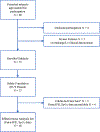Diagnostic accuracy of an over-the-counter infant pulse oximeter for cardiorespiratory events
- PMID: 40355254
- PMCID: PMC12353594
- DOI: 10.1136/archdischild-2025-328540
Diagnostic accuracy of an over-the-counter infant pulse oximeter for cardiorespiratory events
Abstract
Objective: To determine the diagnostic accuracy of an over-the-counter infant pulse oximeter for cardiorespiratory events.
Design: Single-centre prospective diagnostic accuracy study.
Setting: University of Alabama at Birmingham.
Patients: Infants weighing ≥1500 g, <44 weeks' postmenstrual age (PMA) and off ventilator/continuous positive airway pressure support.
Interventions: Test device for 48 hours in addition to standard hospital monitors, ECG and pulse oximetry.
Main outcome measures: Data were time aligned and analysed using MATLAB. The coprimary outcomes were the diagnostic accuracy of the test device for the detection of events with heart rate (HR) <50 beats per minute (bpm) and events with oxygen saturations (SpO2) <80% for ≥3 s.
Results: 66 infants with a median gestational age of 31 weeks (range 23-40) were studied at a median 35 weeks' PMA (range 32-42) weighing 1930 g (range 1500-3605 g) from April to July 2023. The sensitivity for detection of HR <50 bpm ≥3 s was 6% and 39% for smoothed and raw data, respectively, while the specificity was >99% for both smoothed and raw data. The sensitivity for SpO2 <80% ≥3 s was 14% and 74%, while the specificity was >99% and 96% for smoothed and raw data, respectively. Sensitivity for bradycardia events was higher for events with longer durations and/or when using higher thresholds. Sensitivity was higher for hypoxaemia events with longer durations and/or when using higher thresholds.
Conclusion: An over-the-counter infant pulse oximeter had high specificity for bradycardia and hypoxaemia events consistent with a low false alarm rate. Sensitivity improved with longer events and higher event thresholds.
Trial registration number: NCT05774470.
Keywords: Neonatology; Paediatrics; Respiratory Medicine.
© Author(s) (or their employer(s)) 2025. Re-use permitted under CC BY-NC. No commercial re-use. See rights and permissions. Published by BMJ Group.
Conflict of interest statement
Competing interests: None declared.
Figures

References
-
- Meny RG, Carroll JL, Carbone MT, Kelly DH. Cardiorespiratory recordings from infants dying suddenly and unexpectedly at home. Pediatrics. 1994. Jan;93(1):44–9. - PubMed
-
- Moon RY, Carlin RF, Hand I; TASK FORCE ON SUDDEN INFANT DEATH SYNDROME AND THE COMMITTEE ON FETUS AND NEWBORN. Sleep-Related Infant Deaths: Updated 2022 Recommendations for Reducing Infant Deaths in the Sleep Environment. Pediatrics. 2022. Jul 1;150(1):e2022057990. doi: 10.1542/peds.2022-057990. - DOI - PubMed
Associated data
Grants and funding
LinkOut - more resources
Full Text Sources
Medical
Miscellaneous
